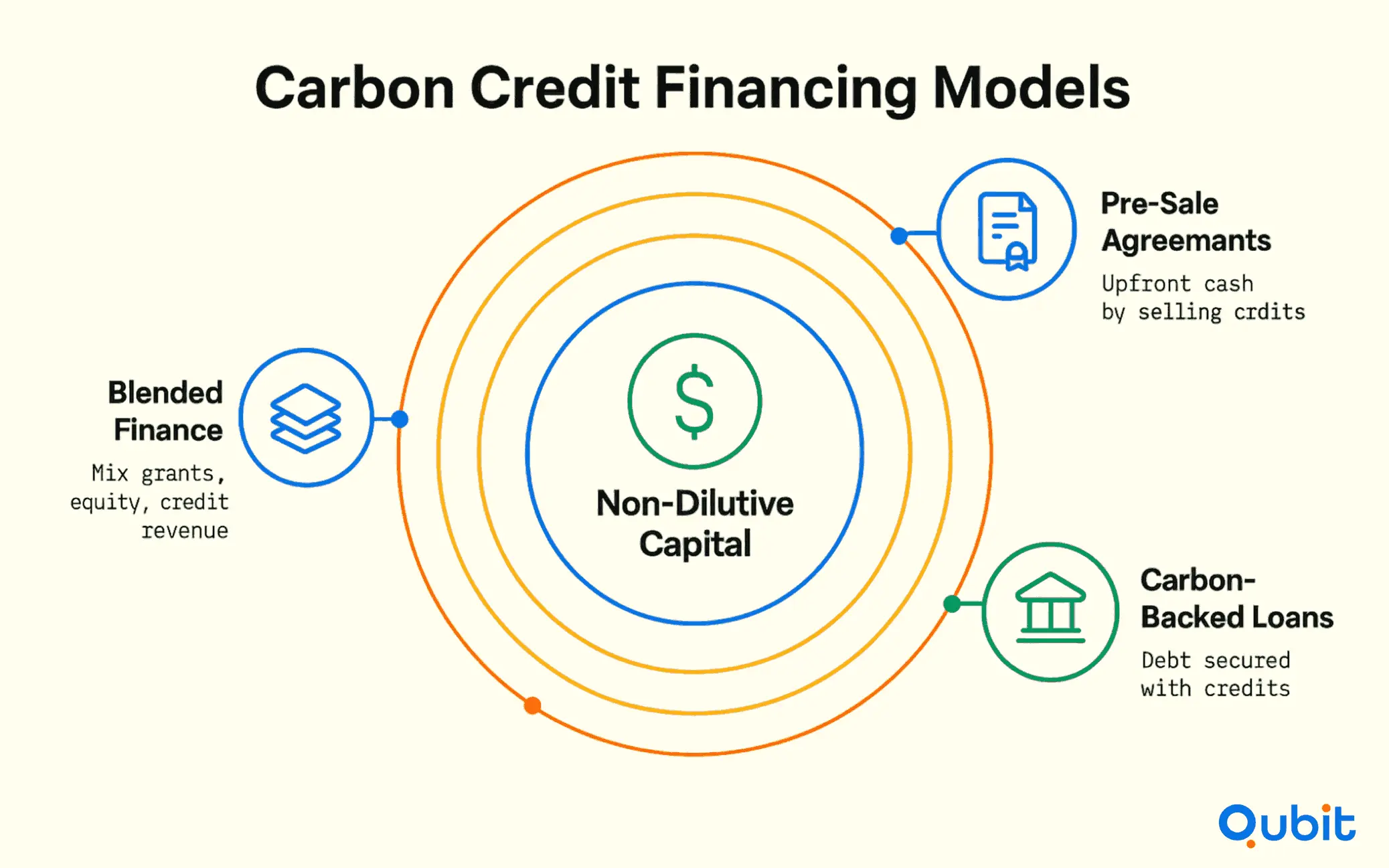Carbon credits are emerging as a transformative tool in climate finance, offering startups a unique pathway to secure funding without diluting equity. As global commitments to carbon reduction surpass $43 billion, businesses are increasingly exploring innovative ways to monetize these credits. This approach not only aligns with sustainability goals but also provides a critical source of non-dilutive capital for scaling operations.
Your insights on funding avenues are further enhanced by series B cleantech manufacturing funding, which details strategies for manufacturing scale‐up in advanced stages of development.
In this article, we’ll uncover how carbon credits can serve as a financial lifeline for climate-focused startups, diving into funding models and real-world case studies. Let’s jump right in.
How Businesses Can Generate Carbon Credits
Generating carbon credits begins with identifying verifiable emission reduction or carbon sequestration activities. Businesses can create credits through projects such as reforestation, soil carbon sequestration, methane capture, renewable energy generation, or energy efficiency improvements. Establishing robust measurement, reporting, and verification (MRV) systems is critical to ensure credibility and market acceptance.
For example, landowners can enroll in carbon offset programs by documenting land use and management practices, as seen with agriculture-focused startups that pay farmers for sequestered carbon. This process often involves registering with recognized carbon credit standards and submitting data for third-party verification.
Climate Finance Startups: Empowering Non-Dilutive Capital Through Carbon Credits
Climate finance startups are transforming the way businesses and individuals approach sustainability, introducing innovative funding mechanisms that align economic returns with environmental benefits. By monetizing carbon credits, these startups are unlocking non-dilutive capital, enabling growth without sacrificing equity.
The Rise of Carbon Credit Monetization
The global voluntary carbon credit market has seen remarkable growth, with USD 43 billion committed or raised for carbon-credit activities between 2021 and Q3 2024. This surge highlights the increasing demand for sustainable financing solutions. Global carbon-credit commitments demonstrate the scale of this activity, attracting investors eager to support climate-friendly initiatives.
Projections for compliance carbon credit markets further underscore their potential. By 2034, these markets are expected to grow from USD 113.1 billion in 2024 to USD 458.4 billion, driven by a compound annual growth rate (CAGR) of 15.6%. Such robust growth reflects the long-term viability of carbon credits as a financial instrument.
Innovative Financing Models
Climate finance startups are pioneering solutions that address energy inequality while promoting sustainability. Platforms like SolarMoney focus on clean energy adoption in under-resourced regions, particularly in Africa. These models bridge gaps in energy access, ensuring that environmental dividends are paired with economic returns.
Additionally, blockchain technology is revolutionizing carbon credit trading. Startups such as Senken utilize tokenized systems to enhance transparency and efficiency in transactions. This approach reduces friction and fosters trust in the carbon credit market, making it easier for businesses to participate in sustainable practices.
Accessible Investment Opportunities
Investors now have the chance to engage with climate-friendly projects at low entry points. Platforms like Climatize allow individuals to start investing in sustainability initiatives with as little as $10. This democratization of climate finance ensures that everyone, regardless of financial capacity, can contribute to global sustainability goals.
For startups seeking to scale after capitalizing on carbon credits, exploring public-market routes such as a cleantech IPO provides a strategic pathway for growth. These exit strategies align with the broader funding landscape, offering opportunities for long-term expansion.
Climate finance startups are proving that sustainability and profitability can coexist, driving innovation while addressing pressing environmental challenges.
Innovative Platforms and Technologies Driving Carbon Credit Monetization
Blockchain and tokenization are revolutionizing carbon credit transparency and liquidity. Platforms leveraging blockchain technology enable secure tracking, trading, and retirement of carbon credits, reducing fraud and double counting. Tokenized carbon credits can be fractionalized and traded more efficiently, opening access to a broader investor base.
Gamified platforms are also emerging, enabling individuals to participate in carbon offsetting through verified eco-actions, with rewards and financial incentives. This democratizes access and increases public engagement in sustainability efforts.
Financing Models Leveraging Carbon Credits

- Pre-Sale Agreements: Developers can pre-sell future carbon credits at discounted rates to raise upfront capital, improving project cash flow and reducing risk.
- Carbon-Backed Loans: Lenders may provide debt financing secured against expected carbon credit revenues.
- Blended Finance: Combining grants, equity, and carbon credit revenues to de-risk early-stage projects.
These models enable startups to access non-dilutive capital, preserving equity while accelerating growth.
Real-World Case Studies
- Indigo Agriculture pays farmers for carbon sequestration, providing a steady income stream while scaling sustainable agriculture.
- SolarMoney facilitates clean energy adoption in underserved regions by linking carbon credit generation to energy access projects.
- Senken uses blockchain to tokenize carbon credits, enhancing market transparency and investor confidence.
Highlighting such examples illustrates practical pathways for startups to monetize carbon credits effectively.
Challenges and Best Practices
Monetizing carbon credits requires navigating complex regulatory frameworks, ensuring additionality (that reductions are beyond business-as-usual), and maintaining rigorous verification. Startups should:
- Conduct thorough due diligence on standards and registries.
- Build strong MRV systems to ensure credibility.
- Engage with reputable marketplaces and brokers.
- Monitor evolving policies and market dynamics closely.
The Future Outlook: Scaling Carbon Credit Impact
With projections suggesting the voluntary carbon market could reach $50 billion by 2030 and compliance markets expanding rapidly, carbon credit monetization is poised to become a cornerstone of climate finance. Startups that innovate in generation, verification, and trading platforms will unlock significant non-dilutive capital and drive global decarbonization.
Conclusion
Innovative climate finance startups are reshaping the funding landscape by utilizing carbon credit monetization as a source of non-dilutive capital. Throughout this article, we’ve explored core strategies, market statistics, and emerging trends that highlight the potential of these approaches. Practical case studies further illustrate how businesses are successfully integrating sustainable funding models into their operations.
For those seeking additional insights into broader funding channels, our discussion complements the cleantech startup fundraising strategies, which offer a wider perspective on sustainable financing.
If you're ready to take the next step and identify the best-fit investors for your sustainable projects, we at Qubit Capital can assist with our Investor Discovery and Mapping service. Let’s work together to turn your vision into reality.
Key Takeaways
- Climate finance startups are pioneering non-dilutive capital strategies through carbon credit monetisation.
- The market for carbon credits is experiencing significant growth with projections indicating robust long‐term potential.
- Innovative platforms like Climatize and SolarMoney are making sustainable investments more accessible.
- Advanced technologies such as blockchain are transforming transparency and efficiency in carbon credit trading.
- Engaging with specialized funding services can help startups secure the right financial backing for sustainable projects.
Frequently asked Questions
What is carbon credit financing?
Carbon credit financing involves funding mechanisms that utilize the monetary value of carbon credits. These credits provide an alternative source of non-dilutive capital, supporting sustainable projects and environmental initiatives.


 Back
Back



